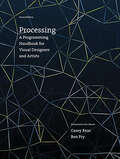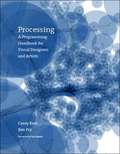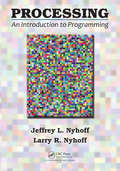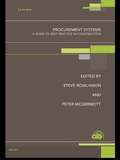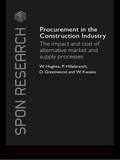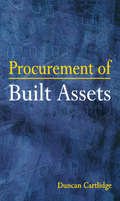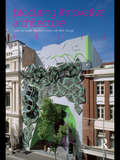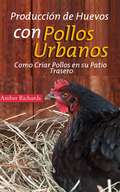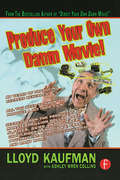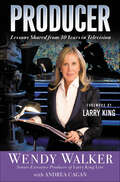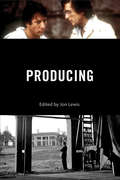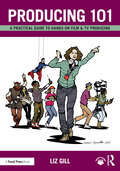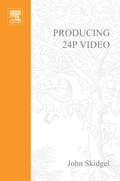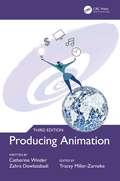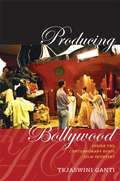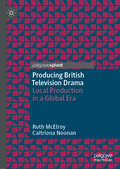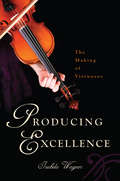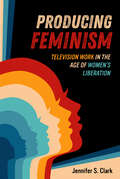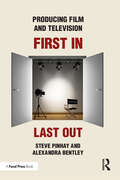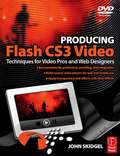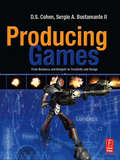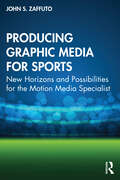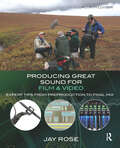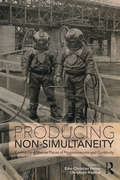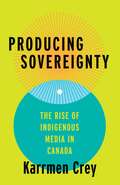- Table View
- List View
Processing, second edition: A Programming Handbook for Visual Designers and Artists
by Ben Fry Casey ReasThe new edition of an introduction to computer programming within the context of the visual arts, using the open-source programming language Processing; thoroughly updated throughout. The visual arts are rapidly changing as media moves into the web, mobile devices, and architecture. When designers and artists learn the basics of writing software, they develop a new form of literacy that enables them to create new media for the present, and to imagine future media that are beyond the capacities of current software tools. This book introduces this new literacy by teaching computer programming within the context of the visual arts. It offers a comprehensive reference and text for Processing (www.processing.org), an open-source programming language that can be used by students, artists, designers, architects, researchers, and anyone who wants to program images, animation, and interactivity. Written by Processing's cofounders, the book offers a definitive reference for students and professionals. Tutorial chapters make up the bulk of the book; advanced professional projects from such domains as animation, performance, and installation are discussed in interviews with their creators.This second edition has been thoroughly updated. It is the first book to offer in-depth coverage of Processing 2.0 and 3.0, and all examples have been updated for the new syntax. Every chapter has been revised, and new chapters introduce new ways to work with data and geometry. New “synthesis” chapters offer discussion and worked examples of such topics as sketching with code, modularity, and algorithms. New interviews have been added that cover a wider range of projects. “Extension” chapters are now offered online so they can be updated to keep pace with technological developments in such fields as computer vision and electronics.InterviewsSUE.C, Larry Cuba, Mark Hansen, Lynn Hershman Leeson, Jürg Lehni, LettError, Golan Levin and Zachary Lieberman, Benjamin Maus, Manfred Mohr, Ash Nehru, Josh On, Bob Sabiston, Jennifer Steinkamp, Jared Tarbell, Steph Thirion, Robert Winter
Processing: A Programming Handbook for Visual Designers and Artists
by Ben Fry John Maeda Casey ReasAn introduction to the ideas of computer programming within the context of the visual arts that also serves as a reference and text for Processing, an open-source programming language designed for creating images, animation, and interactivity.
Processing: An Introduction to Programming
by Jeffrey L. Nyhoff Larry R. NyhoffThis book demonstrates how Processing is an excellent language for beginners to learn the fundamentals of computer programming. Originally designed to make it simpler for digital artists to learn to program, Processing is a wonderful first language for anyone to learn. Given its origins, Processing enables a multimodal approach to programming instruction, well suited to students with interests in computer science or in the arts and humanities. The book uses Processing’s capabilities for graphics and interactivity in order to create examples that are simple, illustrative, interesting, and fun. It is designed to appeal to a broad range of readers, including those who want to learn to program to create digital art, as well as those who seek to learn to program to process numerical information or data. It can be used by students and instructors in a first course on programming, as well as by anyone eager to teach them self to program. Following a traditional sequence of topics for introducing programming, the book introduces key computer science concepts, without overwhelming readers with extensive detail. Additional exercises are available, as are other supplementary materials for instructors looking to introduce even more computer science concepts associated with the topics. Several online chapters are also provided that introduce slightly more advanced topics in Processing, such as two-dimensional arrays, manipulation of strings, and file input and output. The conversational style and pace of the book are based upon the authors’ extensive experience with teaching programming to a wide variety of beginners in a classroom. No prior programming experience is expected.
Procurement Systems: A Guide to Best Practice in Construction
by Peter McDermott Steve RowlinsonProcurement Systems details the whole spectrum of procurement issues in the construction industry, starting with the client /customer and running through managerial, cultural and IT-based issues. The book commences with an overveiw of previous work and a section on selection criteria is provided to enable practitioners to make their choices of procurement form. Importantly, perfromance comparisons of different procurement forms are discussed and the main emphasis of the book is to highlight best practice based on the most up-to-date research. One chapter deals specifically with developmentally orientated procurement issues in NICs (newly industrialised countries), where best practice is assessed from a different set of perspectives. The authors contributing to this book are among the most highly respected and eminent in the field.
Procurement in the Construction Industry: The Impact and Cost of Alternative Market and Supply Processes (Spon Research)
by William Hughes David Greenwood Patricia M. Hillebrandt Wisdom KwawuDo recent moves in the construction industry towards collaborative working and other new procurement procedures really make good business sense? Procurement in the Construction Industry is the result of research into this question and it includes the first rigorous categorizing of the differences between procurement methods currently in use. In the process of carrying out this research, the team has produced a comprehensive study of procurement methods which looks in detail at the relative benefits and costs of different ways of working, with sometimes surprising results. As such, it is not only a valuable guide for practitioners on the complexities of the procurement process, but also an outline of the relevance of economic theory to the construction sector.
Procurement of Built Assets
by Duncan CartlidgeThe ability to successfully procure built assets is at the heart of the construction process and in turn at the heart of the procurement process is identifying the constantly evolving needs of the construction client. Despite client criticism and a mountain of reports and statistics, spanning both the public and private sectors, until now the construction industry has failed to transform the diverse and often separate and inefficient processes of design and procurement of built assets into one single integrated production process. There are now signs however that the construction industry is beginning to transform its approach to built asset procurement and client care.This book draws heavily on the experiences and best practice of other industries and market sectors who have, just as construction is now having to do, taken a critical look at their procurement practices and techniques and the inherent waste in many traditional systems. The text includes practice-based case studies, from both the public and private sectors, to demonstrate how new procurement approaches are delivering value for money over the life cycle of built assets.This book is recommended reading for a range of students in the field of the built environment from quantity surveyors and commercial managers to architects and an essential and comprehensive guide to all construction procurement professionals seeking to familiarise themselves with the latest approaches to procurement.
Procuring Innovative Architecture
by Leon van Schaik Geoffrey LondonThe case studies in this book describe how clients’ promotion of innovative communities of practice has led to important collections of architectural works. The book provides an assessment of the effectiveness of their approaches. Architects and clients will understand what to look for as they construct their careers and their portfolios with innovation as a goal. It is taken for granted nowadays that supporting innovative architecture benefits society. In countries as diverse as Austria, Australia, Belgium, England, Japan, South East Asia, Slovenia, Spain, Switzerland and the USA, retailers, institutions, local and regional government and transport authorities have established substantial bodies of work by new and emerging architects. This books looks at what their goals are and how they have achieved them. Is it possible to promote sustainable communities of innovative practice through such patronage? Can innovation be ‘kick-started’ by importing visionary works?
Producción De Huevos Con Pollos Urbanos. Como Criar Pollos En Su Patio Trasero
by Amber Richards David GarayProducción de Huevos con Pollos Urbanos Como Criar Pollos en su Patio Trasero ¿Cree que necesita tener una granja o vivir en el campo para criar pollos? ¡Piénselo de nuevo! La crianza de pollos se ha vuelto cada vez más común en zonas urbanas y los beneficios son asombrosos. Y si a usted le preocupa pueda llegar a ser demasiado trabajo o que es mejor sólo comprar una docena en el supermercado, pues tenemos noticias para usted. Producción de Huevos con los Pollos Urbanos: Cómo Criar Pollos en su Patio Trasero resuelve todas estas conjeturas y preocupaciones comunes. Esta guía responderá las preguntas más importantes, ofreciendo un proceso de creación de un nuevo gallinero para su bandada de emplumados y al final se sentirá como un profesional. Proveer huevos frescos y orgánicos a su familia nunca ha sido tan fácil. Mejor aun sabiendo que han sido producidos en un entorno humano y que el cuidado que ha creado para usted mismo no tiene precio. Eche un vistazo a contenido del libro: Razones para Criar sus Propios Pollos Antes de Empezar a Criar Pollos ¿Qué Razas de Pollos Debería Considerar? Donde Conseguir los Pollos ¿Debería tener un Gallo? Instale un Gallinero ¿Cuántos Pollos Debería Tener? Alimente y Abreve sus Pollos Mantenga sus Pollos Saludables Precauciones Importantes de Salubridad en la Crianza de Aves de Corral Recolección y Limpieza de los Huevos El cuidado de los pollos es también un proyecto educativo de 4H para los niños. Estos amigos emplumados tienen grandes personalidades los cuales le enseñarán responsabilidad y proporcionarán oportunidades de vinculación para toda la familia. Si usted está contemplando empezar la crianza de pollos, no busques más.
Produce Your Own Damn Movie!
by Lloyd KaufmanOften low-budget filmmakers get thrown into the position of being not only the director, but their own producer. Using tips from the finest washed-up has-been producers in the business, this book will give the low-budget filmmaker practical tools for getting a movie shoot started, and keeping it going until it is supposed to end. From budgeting concerns to production-damaging acts of God, all will be discussed.
Producer: Lessons Shared from 30 Years in Television
by Andrea Cagan Wendy WalkerFor the past seventeen years, Wendy Walker has been the "woman behind the man" at Larry King Live. As King's senior executive producer, she has been responsible for landing exclusive interviews with the most important newsmakers and well-known celebrities from around the globe that have been the hallmark of CNN's iconic show.From the shocking death of Michael Jackson to the first television interview with the Watergate scandal's Deep Throat, Wendy Walker has a wealth of never-before-shared stories involving the most relevant events and people of our time.Starting as an ABC secretary over thirty years ago, she has risen through the male-dominated world of television production. Her passion, intellect, and work ethic are undeniable, but it's her heart that has always been her guide. It's with the same zeal and loving spirituality that she shares the insights gained during her long climb to the top. With empowering advice and inspirational thoughts, Wendy Walker has not only gained a lifetime of experience, but the wisdom to know that it needs to be shared.
Producing
by Mark Lynn Anderson Jon Lewis Bill Grantham Douglas Gomery Saverio Giovacchini Professor Joanna E. Rapf Professor Toby MillerOf all the job titles listed in the opening and closing screen credits, producer is certainly the most amorphous. There are businessmen (and women)-producers, writer-director- and movie-star-producers; producers who work for the studio; executive producers whose reputation and industry clout alone gets a project financed (though their day-to-day participation in the project may be negligible). The job title, regardless of the actual work involved, warrants a great deal of prestige in the film business; it is the credited producers, after all, who collect the Oscar for Best Picture. But what producers do and what they don't or won't do varies from project to project. Producing is the first book to provide a comprehensive overview of the roles that producers have played in Hollywood, from the dawn of the twentieth century to the present day. It introduces readers to the colorful figures who helped to define and reimagine the producer's role, including inventors like Thomas Edison, moguls like Darryl F. Zanuck, entrepreneurs like Walt Disney, and mavericks like Roger Corman. Readers also get an inside look at the less glamorous jobs producers have often performed: shepherding projects through many years of development, securing financial backers, and supervising movie shoots. The latest book in the acclaimed Behind the Silver Screen series, Producing includes essays written by seven film scholars, each an expert in a different period of cinema history. Together, they give readers a full picture of how the art and business of producing films has changed over time--and how the producer's myriad job duties continue to evolve in the digital era.
Producing 101: A Practical Guide to Hands-On Film & TV Producing
by Liz GillThis book offers a step-by-step exploration of a Producer’s on-set responsibilities within the context of creating a TV series or feature film.Being a successful Producer requires you to have an intimate understanding of global finances, law, union rules and negotiating. The role also requires solid filmmaking skills from scriptwriting to scheduling, casting to cutting and sound mixing to marketing. But most important of all these skills is leadership – building a team and facilitating a collection of highly trained (and often artistically temperamental) individuals to do their best collective work. This book describes best practice across geographical jurisdictions, identifying key universal principles as well as the specific and unique detail work that make a great Producer. Each chapter offers meaningful advice from experienced industry experts, useful examples including real-world templates of crucial paperwork, and preventative measures that can be implemented. Producers of all backgrounds will benefit from clear, concise writing that outlines industry standard structures, protocols and processes – and why they work.This book will prove invaluable to people starting out in their careers, but also those interested in exploring producing who come from other departments – such as Assistant Directors, Production Managers and Line Producers – and those changing formats, such as from TV to film.
Producing 24p Video: Covers the Canon XL2 and the Panasonic DVX-100a DV Expert Series
by John SkidgelProducing 24pP Video demystifies the emerging standards of film and video production and discusses the 24p video film format to help novice and experienced filmmakers alike learn how to better use the newly available DV cameras. Since the 24p frame rate closely approximates the look and feel of film, it is the speed of choice whenever a "cinematic" look is desired. 24p video also offers certain compression options that are advantageous to web and wireless delivery. This full-color book discusses the special techniques required by 24p productions - all the way through the production, from preproduction planning through post and output. Each chapter includes techniques, examples, tips, and case studies. The field techniques section features real-world setups presented as demonstrations or as tutorials. Case studies present profiles of people producing 24p projects, and the DVD includes step-by-step instructions that illustrate how to work with 24p material in NLE, compositor, DVD authoring, and audio applications.
Producing Animation 3e
by Catherine Winder Zahra DowlatabadiProducing Animation is a comprehensive guide to the production industry. Already a relied upon resource by professionals and students alike, this book covers the process from script to screen while defining the role of the producer at each phase. The second edition features new content such as sidebars on key topics from industry experts, discussions on CG, 2D and stereoscopic production processes, and an overview on marketing and distributing your project. The companion website provides access to sample tables, templates and workflow outlines for CG and 2D animation production. Key Features A complete guide to identifying, pitching, developing, and producing an animated show with detailed resources for production planning, budgeting, scheduling, tracking, delivering, marketing, and distribution. Tools to establish the best production practices for your project with insight into the inner workings of animation production at successful studios both large and smal A unique collection of the knowledge, experience, and advice of industry professionals on a wide variety of topics, from selling your project to setting up a co-production to stereoscopic filmmaking. Versatile and practical sample charts, tables and templates for CG and 2D animation production to help launch your project with solid processes and procedures
Producing Bollywood: Inside the Contemporary Hindi Film Industry
by Tejaswini GantiProducing Bollywood offers an unprecedented look inside the social and professional worlds of the Mumbai-based Hindi film industry and explains how it became "Bollywood," the global film phenomenon and potent symbol of India as a rising economic powerhouse. In this rich and entertaining ethnography Tejaswini Ganti examines the changes in Hindi film production from the 1990s until 2010, locating them in Hindi filmmakers' efforts to accrue symbolic capital, social respectability, and professional distinction, and to manage the commercial uncertainties of filmmaking. These efforts have been enabled by the neoliberal restructuring of the Indian state and economy since 1991. This restructuring has dramatically altered the country's media landscape, which quickly expanded to include satellite television and multiplex theaters. Ganti contends that the Hindi film industry's metamorphosis into Bollywood would not have been possible without the rise of neoliberal economic ideals in India. By describing dramatic transformations in the Hindi film industry's production culture, daily practices, and filmmaking ideologies during a decade of tremendous social and economic change in India, Ganti offers valuable new insights into the effects of neoliberalism on cultural production in a postcolonial setting.
Producing British Television Drama: Local Production in a Global Era
by Caitriona Noonan Ruth McElroyThis book presents a compelling case for a paradigmatic shift in the analysis of television drama production that recentres questions of power, control and sustainability. Television drama production has become an increasingly lucrative global export business as drama as a form enjoys increased prestige. However, this book argues that the growing emphasis on international markets and global players such as Netflix and Amazon Prime neglects the realities of commissioning and making television drama in specific national and regional contexts. Drawing on extensive empirical research, Producing British Television Drama demonstrates the centrality of public service broadcasters in serving audiences and sustaining the commercial independent sector in a digital age. It attends closely to three elements—the role of place in the production of content; the experiences of those working in the sector; and the interventions from cultural intermediaries in articulating and ascribing value to television drama. With chapters examining the evolution of British TV drama, as well as what might be in store in its future, this book offers invaluable insights into the UK as a major supplier of and market for television drama.
Producing Excellence
by Izabela WagnerDriven by a passion for music, for excellence, and for fame, violin soloists are immersed from early childhood in high-pressure competitions, regular public appearances, and arduous daily practice. An in-depth study of nearly one hundred such children, Producing Excellence illuminates the process these young violinists undergo to become elite international soloists. A musician and a parent of a young violinist, sociologist Izabela Wagner offers an inside look at how her young subjects set out on the long road to becoming a soloist. The remarkable research she conducted--at rehearsals, lessons, and in other educational settings--enabled her to gain deep insight into what distinguishes these talented prodigies and their training. She notes, for instance, the importance of a family culture steeped in the values of the musical world. Indeed, more than half of these students come from a family of professional musicians and were raised in an atmosphere marked by the importance of instrumental practice, the vitality of music as a vocation, and especially the veneration of famous artists. Wagner also highlights the highly structured, rigorous training system of identifying, nurturing, and rewarding talent, even as she underscores the social, economic, and cultural factors that make success in this system possible. Offering an intimate portrait of the students, their parents, and their instructors, Producing Excellence sheds new light on the development of exceptional musical talent, as well as draw much larger conclusions as to "producing prodigy" in other competition-prone areas, such as sports, sciences, the professions, and other arts. Wagner's insights make this book valuable for academics interested in the study of occupations, and her clear, lively writing is perfect for general readers curious about the ins and outs of training to be a violin soloist.
Producing Feminism: Television Work in the Age of Women's Liberation (Feminist Media Histories #6)
by Jennifer S. ClarkA free ebook version of this title is available through Luminos, University of California Press's Open Access publishing program. Visit www.luminosoa.org to learn more. In this deeply archival work, Jennifer S. Clark explores the multiple ways in which women's labor in the American television industry of the 1970s furthered feminist ends. Carefully crafted around an impressive assemblage of interviews and primary sources (from television network memos to programming schedules, production notes to executive meeting agendas), Clark tells the story of how women organized in the workplace to form collectives, affect production labor, and develop reform-oriented policies and philosophies that reshaped television behind the screen. She urges us to consider how interventions, often at localized levels, can collectively shift the dynamics of a workplace and the cultural products created there.
Producing Film and Television: First In, Last Out
by Steve Pinhay Alexandra BentleyThis book is about what it takes to be a producer, the person responsible for getting a project off the ground and seeing it through to a conclusion sometimes years after things got started. For this reason, a thing often said about producers is that they are “first in and last out”, meaning they are there at the start of a film or television series and still there when everyone else has gone on to their next project. Written by two highly experienced television and film producers, this is the ultimate guide to navigating the world of film and television production in the UK – with lessons for anyone working or wanting to work in these industries across the world.The book covers all types of television and film production, including drama, documentary, entertainment, comedy and children's programming. Through its step-by-step breakdowns of industry practices, first-hand insights and unique checklists, it gives readers a behind-the-scenes look at what it takes to succeed in these competitive fields. In addition, each section presents a deep dive into the mysteries of getting into the industry and useful infographics on key elements of the producing process.Directed towards students, recent graduates or seasoned professionals looking to change direction, this book will help readers break into film and television industries or take their career to the next level.
Producing Flash CS3 Video: Techniques for Video Pros and Web Designers
by John Skidgel* Best practices for production, encoding, and integration* Build custom video players for web and mobile use* Apply transparency and effects with After EffectsDesign and develop video applications with Flash Professional CS3. In quick primer chapters, you'll get the best practices for shooting video for Flash distribution and the basics of how to design Flash applications for compelling user experiences. Subsequent chapters demonstrate the integrated use of Flash Professional with Dreamweaver, Device Central, and After Effects in practical tutorials. Annotated ActionScript 3 code gives you the facility to build your video applications.In 27 progressive tutorials, you'll acquire practical experience in the cutting edge techniques for:* Encoding single files, batch files, and embedding cue points in video.* Customizing FLVPlayback components* Building Flash Video players from scratch to include cue points, full screen events, and current playback time* Applying transparency, masks, and effects to enhance Flash Video.* Looping Flash Video continuously or in creative combinations* Embedding Flash Video in HTML pages for web deployment* Integrating Flash Video with XML, closed caption text, and JavaScript* Preparing video for streaming servers and mobile devices including a Flash Lite application with device videoThe companion DVD-ROM contains project media for all 27 tutorials that teach the nuts and bolts of implementing video in Flash applications on web pages and on alternative devices.
Producing Games: From Business and Budgets to Creativity and Design
by D S. Cohen Sergio A. BustamanteComputer games are big business - tens of billions of dollars are spent annually by the worldwide video games market. The cost of producing video games has ballooned to beyond $20 million dollars in many cases, and team sizes are quickly growing past 100 team members. At the center of this storm is the producer - one person who transforms the money, the hours spent by the team, and the latest technology into a work of art that millions of people will call fun. This book will dig deeply into the role of the producer and expose secrets of game production that stand the test of time: how to build a great team, how to plan a major game development project, and how to pull the development team toward the vision of a great game.
Producing Graphic Media for Sports: New Horizons and Possibilities for the Motion Media Specialist
by John S. ZaffutoProducing Graphic Media for Sports: New Horizons and Possibilities for the Motion Media Specialist explores the origins, applications, and future of the production of sports-oriented motion graphics. Beginning with the evolution and development of sports-oriented art and design, this book investigates the importance of motion graphics within a variety of environments in the sphere of organized, competitive activity. Venue-based presentation, broadcast and streaming environments, and the importance of graphic standards and brand guidelines are all discussed in detail, along with applications within social media and mobile platforms. A final chapter on emerging technologies covers the potential use of motion media for e-sports and other trending developments within the sports world. The author draws on case studies and interviews with sports media professionals to augment his own research and observation of trends and processes and to highlight the exciting career opportunities that exist within the sports presentation and marketing industries. This book is recommended reading for students of advanced media production, sports marketing, and media production for advertising.
Producing Great Sound for Film and Video: Expert Tips from Preproduction to Final Mix
by Richard RoseIn Producing Great Sound for Film and Video, Fourth Edition audio guru Jay Rose revises his popular text for a new generation of filmmakers. You’ll learn practical, time-saving ways to get better recordings, solve problems with existing audio, create compelling tracks, and boost your filmmaking to the next level! Here you’ll find real-world advice and practical guidelines for every aspect of your soundtrack: planning and budgeting, field and studio recording, editing, sound effects and music, audio repair, processing, and mixing. Rose’s combination of solid technical information and a clear, step-by-step approach has made this the go-to book for producers and film students for over a decade. New in this edition: Insights and from-the-trenches tips from top professionals Instructions for getting the best results from new DSLRs and digital recorders What you need to know about new regulations for wireless mics and broadcast loudness An expanded "How Do I Fix This?" section to help you solve problems quickly Whether you’re an aspiring filmmaker who wants better tracks, or an experienced professional looking for a reference, Producing Great Sound for Film and Video, Fourth Edition has the information you need.
Producing Non-Simultaneity: Construction Sites as Places of Progressiveness and Continuity
by Eike-Christian Heine Christoph RauhutProducing Non-Simultaneity discusses how the processes of modernisation, driven by globalisation and market forces, change the political, economic and technological conditions under which architecture is realised. The book looks beyond the rhetoric of revolutionary innovation, often put forward by architects and engineers. It shows how technological change during the last 200 years was only possible because traditional skills and older materials persisted. The volume argues that building sites have long been showcases of non-simultaneities. Shedding light on construction of the past and exploring what may impact construction in the future, this book would be a valuable addition for students, researchers and academics in architecture, architectural history and theory.
Producing Sovereignty: The Rise of Indigenous Media in Canada (Indigenous Americas)
by Karrmen CreyExploring how Indigenous media has flourished across Canada from the 1990s to the present In the early 1990s, Indigenous media experienced a boom across Canada, resulting in a vast landscape of film, TV, and digital media. Coinciding with a resurgence of Indigenous political activism, Indigenous media highlighted issues around sovereignty and Indigenous rights to broader audiences in Canada. In Producing Sovereignty, Karrmen Crey considers the conditions—social movements, state policy, and evolutions in technology—that enabled this proliferation. Exploring the wide field of media culture institutions, Crey pays particular attention to those that Indigenous media makers engaged during this cultural moment, including state film agencies, arts organizations, provincial broadcasters, and more. Producing Sovereignty ranges from the formation of the Aboriginal Film and Video Art Alliance in the early 1990s and its partnership with the Banff Centre for the Arts to the Canadian Broadcasting Corporation&’s 2016 production of Highway of Tears—an immersive 360-degree short film directed by Anishinaabe filmmaker Lisa Jackson—highlighting works by Indigenous creators along the way and situating Indigenous media within contexts that pay close attention to the role of media-producing institutions. Importantly, Crey focuses on institutions with limited scholarly attention, shifting beyond the work of the National Film Board of Canada to explore lesser-known institutions such as educational broadcasters and independent production companies that create programming for the Aboriginal Peoples Television Network. Through its refusal to treat Indigenous media simply as a set of cultural aesthetics, Producing Sovereignty offers a revealing media history of this cultural moment.
